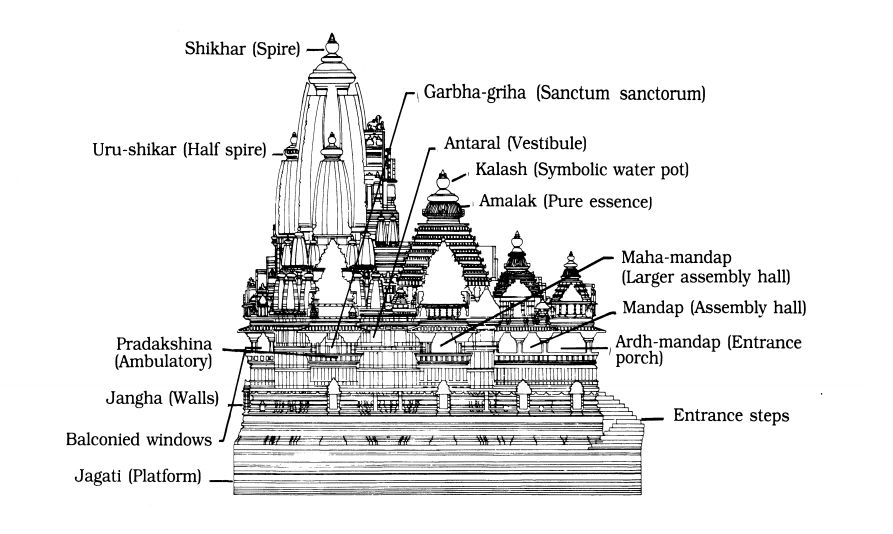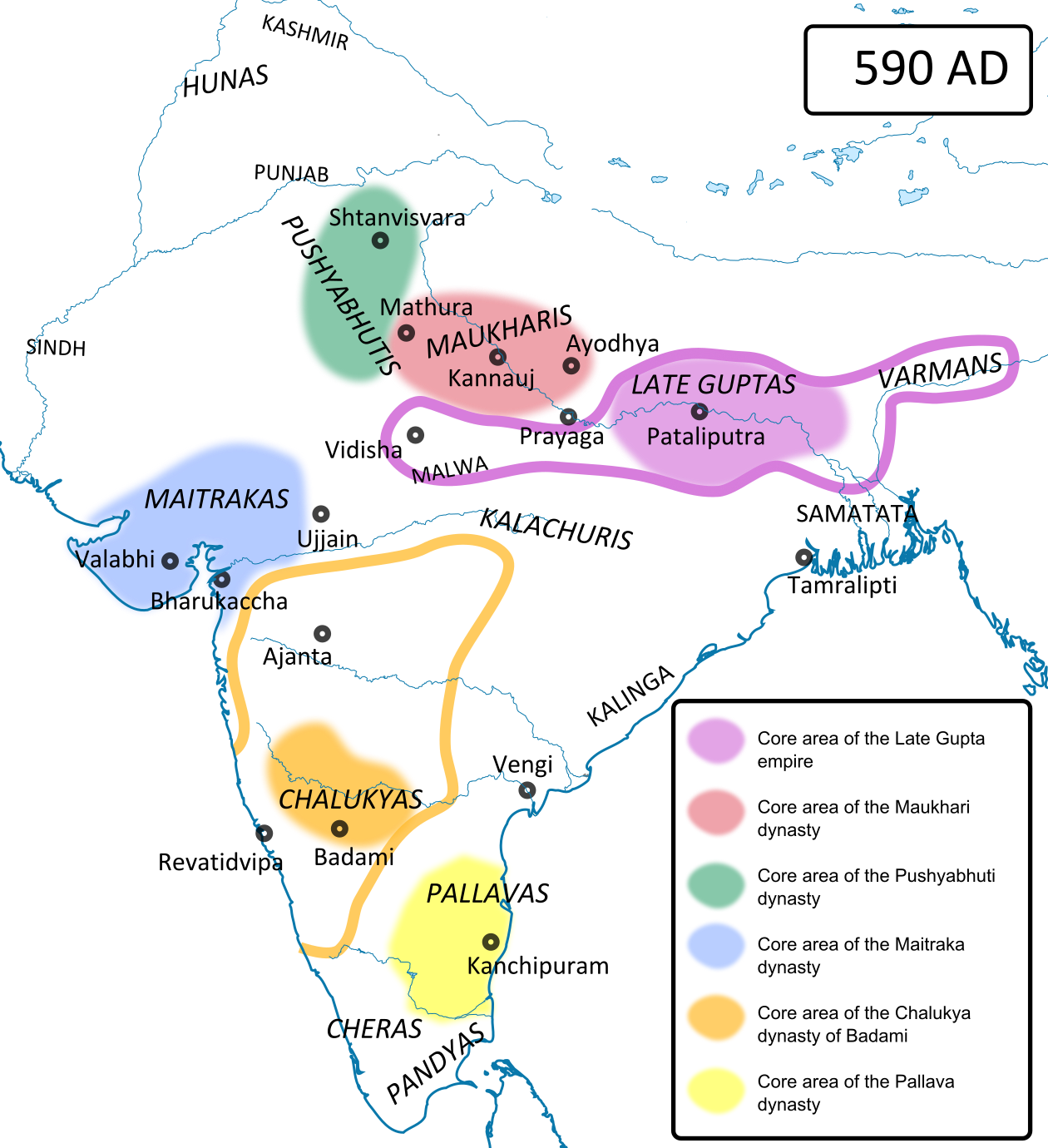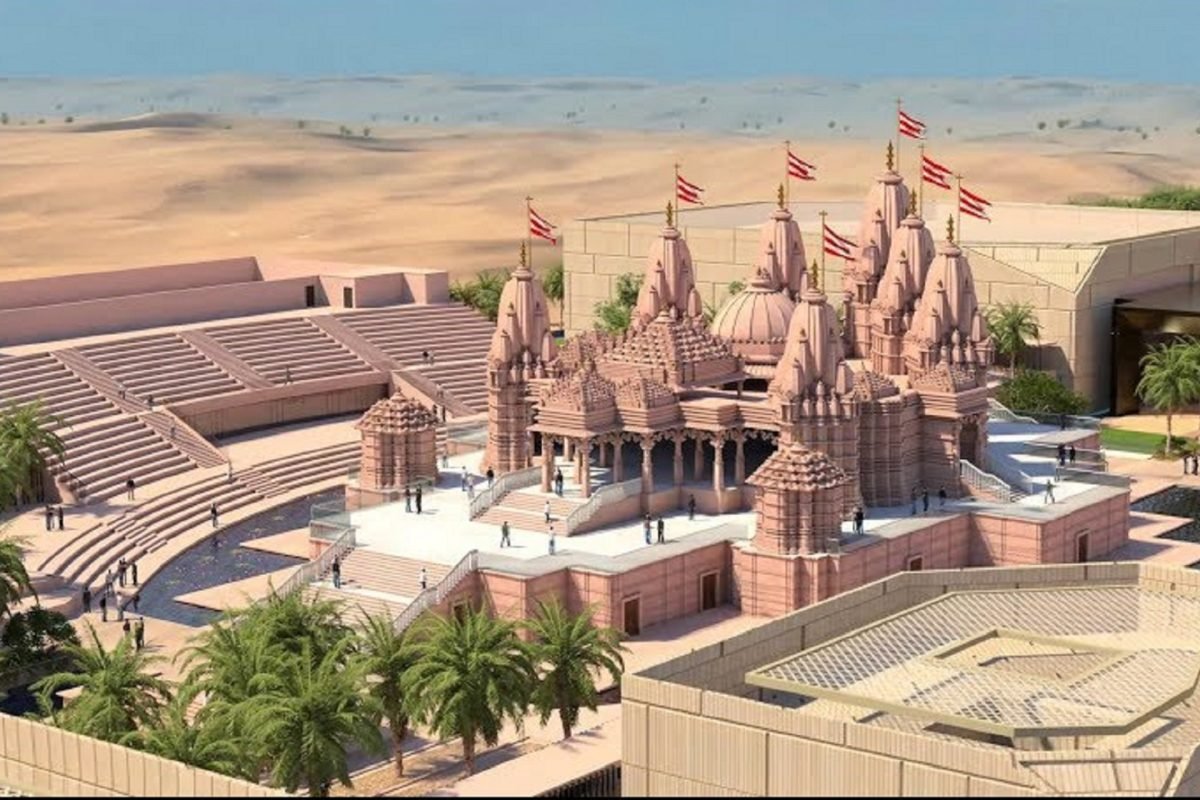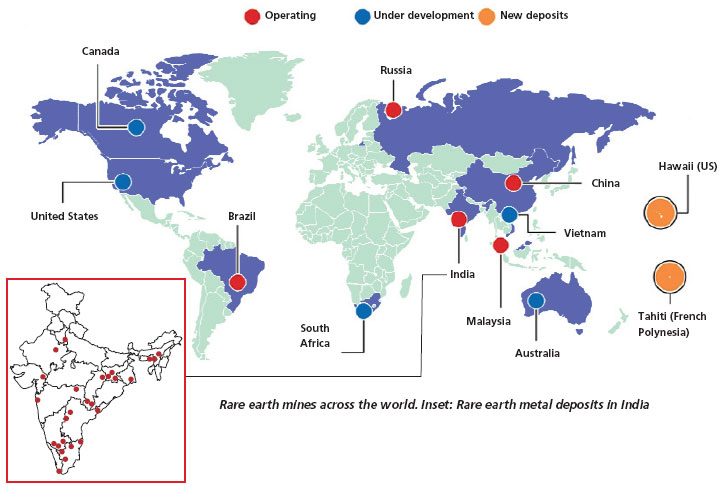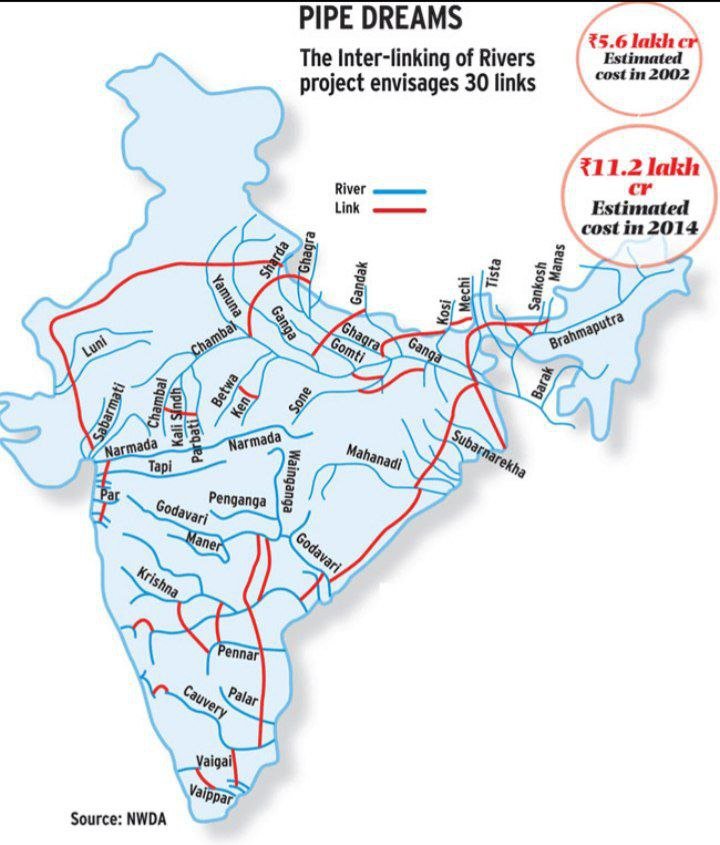
Ram Mandir | Ayodhya
Subscribers of "Current Affairs" course can Download Daily Current Affairs in PDF/DOC
Subscribe to Never Miss an Important Update! Assured Discounts on New Products!
Must Join PMF IAS Telegram Channel & PMF IAS History Telegram Channel
- Context (HT): The Ayodhya Ram mandir was inaugurated recently.
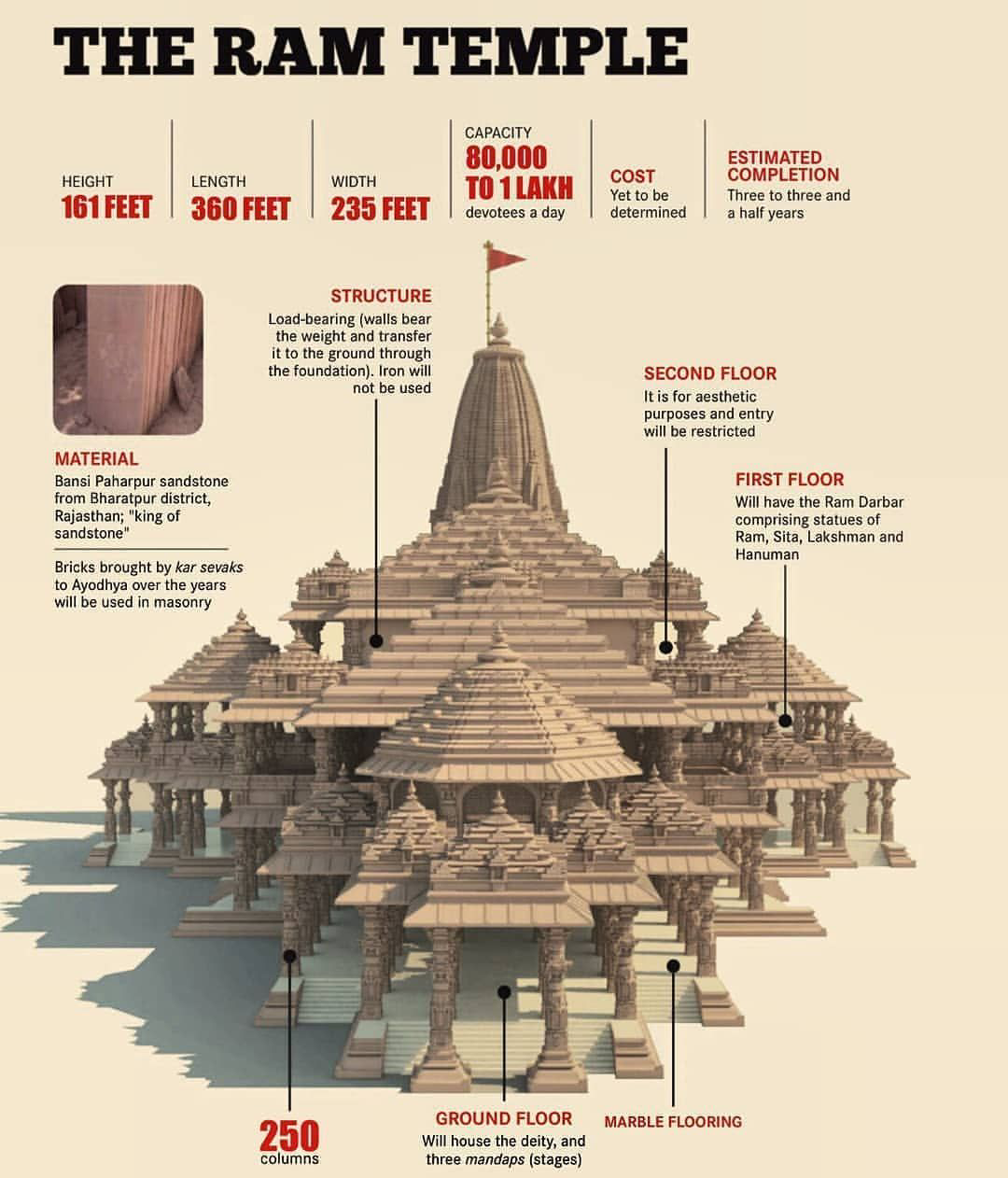
Dimensions
- It is a three-story temple with each floor being 20ft, supported by a total of 392 pillars and 44 doors.
- It has a length of 380 feet, a width of 250 feet, and a height of 161 feet.
Architecture
- It is constructed in the traditional Nagara style.
- Five mandaps: Nritya Mandap, Rang Mandap, Sabha Mandap, Prathana Mandap, and Kirtan Mandap.
- Singh Dwar: The main entrance is on the eastern side, with ascending 32 stairs.
- Garbhagriha (sanctum sanctorum) houses the childhood form of Bhagwan Shri Ram (Shri Ram Lalla), and the first floor houses a Shri Ram Darbar.
- Four Mandirs at four corners – dedicated to deities Shiv, Bhagwati, Ganesh, and Surya.
- Maa Annapurna temple is at the northern end, and Hanuman temple is at the southern end.
- The pillars and walls showcase intricately sculpted depictions of Hindu deities, gods, and goddesses.
- Parkota (Surrounding Rectangular compound wall): Length of 732 meters and a width of 14 feet.
- Kuber Tila (Southwestern part) has an ancient Shiv Mandir along with the Jatayu statue.
- Mandirs of Maharshi Valmiki, Maharshi Vasishtha, Maharshi Vishwamitra, Maharshi Agastya, Nishad Raj, Mata Shabri, and the revered consort of the Devi Ahilya are also proposed in the complex.
Materials used in the construction
- The project uses traditional construction materials, aligning with age-old building practices.
- It does not use iron or steel (Rusting results in a shorter life span).
- Bansi Paharpur Pink Sandstone from Rajasthan’s Bharatpur district is used for major construction.
- Granite stones are utilised in the plinths, providing a durable and resilient foundation for the temple.
- The use of granite adds structural strength while contributing to the overall longevity of the temple.
- White Makrana marble and coloured marble are intricately used for the inlay work.
- A thick layer of roller-compacted concrete (RCC) foundation appearing like artificial rock is laid down.
- Special bricks (Ram Shilas) with the inscription “Shri Ram” on them are used.
- Sculptor Arun Yogiraj carved out the “Balak Ram” idol from the pre-Cambrian era black granite sourced from Mysuru (Karnataka).
Properties of material used
Sandstone
- Sandstone is a sedimentary rock composed mainly of sand-sized silicate grains.
- It may be of any colour due to impurities within the minerals.
- Due to its durability, strength, and aesthetic appeal, it has been used in construction for many years.
- Source: Rajasthan (~90% deposits), Andhra Pradesh, Assam, Bihar, Gujarat, Haryana, Madhya Pradesh, Meghalaya, Mizoram, Karnataka, Odisha, Punjab, Uttar Pradesh, Tamil Nadu and West Bengal.
Granite
- It is an igneous rock formed by slow crystallisation of magma beneath the Earth’s surface (plutonic).
- Mohs hardness scale (used for hardness of minerals) rates it as 6-7 out of 10, making it very durable.
- It has low porosity (no water absorption and no weathering), acid resistance and thermal stability.
- Multiple colours are due to mineral composition, impurities, and rate of formation.
- Source: Odisha, Tamil Nadu, Karnataka, Jharkhand, Chhattisgarh, Rajasthan, Telangana, Andhra Pradesh.
Makrana marble
- Marble is a metamorphic rock composed of carbonate minerals (90%).
- Some other monuments of Makrana marble are the Taj Mahal, Humayun’s Tomb in New Delhi, Dukhnivaran Sahib Gurdwara in Ludhiana, Sheikh Zayed Mosque in Abu Dhabi, Moti Masjid in Lahore and the Victoria Memorial in Kolkata.
- It is designated as Asia’s first Global Heritage Stone Resource (GHSR) by the International Union of Geological Sciences.
- Only single deposit in India: Makrana (Nagaur in Rajasthan)
Surya Tilak
|
Sustainability Provisions
- With no use of iron and steel, it has a lower carbon footprint.
- The complex has a sewage treatment plant, water treatment plant, water supply for fire safety and an independent power station.
- Environmental water conservation (70% of the area left green) is emphasised.
- Bisleri will place 200+ bins around Ayodhya Ram Mandir to collect plastic bottles for recycling.
- Many items used on the day of the ceremony were made using cow dung.
Ayodhya
- Context (IE): Ram Mandir’s consecration has brought Ayodhya into the limelight.
History of Ayodhya
Ancient History
- “Ayodhya” means “not to be fought”. Atharvaveda and Jain literature Adi Purana refers to it as the unconquerable city of gods.
- “Saketa” is the older name for the city as per the Sanskrit, Jain, Buddhist, Greek and Chinese sources.
- Ancient Indian Sanskrit-language epics, Ramayana and the Mahabharata, mention a legendary city called Ayodhya.
- Epics mention it as the capital of the Ikshvaku kings of Kosala, including Lord Ram.
- Ayodhya was the early capital of the kingdom of Kosala, which was later shifted to Shravasti.
- It is also mentioned in Kalidasa’s Raghuvamsha.
- The Vayu Purana and the Brahmanda Purana attest that the early Gupta kings ruled Saketa. Still, no Gupta-era archaeological layers have been discovered except for many Gupta coins.
- Karamdanda (Karmdand) inscription of Kumaragupta I names it as the capital of the Kosala province.
- The Hunas (Mihirakula) invasion in the 6th century is the probable cause of the decline of Ayodhya.
- In the 11th-12th century, the Kanauj kingdom arose in Ayodhya (Oudh/Awadh).
- After the fall of Harsha’s Kannauj empire, it was supposedly under Gurjara-Pratiharas kings.
- The Gahadavala dynasty came to power in the region (11th century) and promoted Vaishnavism.
Buddhist connection
- It is identical to Saketa, where the Buddha is said to have resided for some time.
- Samyutta Nikaya and the Vinaya Pitaka mention the city of Saketa and a big river near it.
- The later Buddhist text Mahavastu describes Saketa as the seat of the Ikshvaku king Sujata.
- Chinese Buddhist monk Fa-Hian (5th century CE) mentioned multiple monasteries in Ayodhya.
- Ashoka is also believed to have constructed a stupa in Ayodhya.
Jainism connection
- Jain canonical text Jambudvipa-Pannati describes a city called Viniya (synonyms with Ayodhya) as the birthplace of Lord Rishabhdev (1st Tirthankar).
Medieval Period
- Ayodhya became part of the Delhi Sultanate, the Jaunpur Kingdom, and the Mughal Empire.
- Babri Mosque was built in 1528–29 by Mir Baqi, a commander of the Mughal emperor Babur.
- After the death of Aurangzeb in 1707 AD, the central Muslim rule weakened, and Awadh became virtually independent, with Ayodhya as its capital.
British Period
- It became subordinate to the British East India Company in 1764.
- The first capital of Oudh/Awadh was Ayodhya, later Faizabad.
- Treaty of Allahabad (1765) after the Battle of Buxar resulted in the transfer of 50 lakhs by Nawab of Awadh to Britishers.
- Awadh Annexation (1856) by Dalhousie’s Doctrine of Lapse was a factor in the 1857 revolution.
- Oudh was joined with the Agra Presidency in 1877 to form the North-Western Provinces and later the United Provinces of Agra and Oudh, now Uttar Pradesh state.
Post-independence
- Excavations at Ayodhya discovered a large brick wall (fortification wall) by archaeologist B. B. Lal.
- It has been the centre of the Ram Janambhoomi movement.
Geography
- It is situated in the Indo-Gangetic Plain with a subtropical monsoon climate.
- It is located on the southern bank of the Saryu River.
Saryu/Sarju River
- Origin: Nanda Kot mountain (Sarmaul, Bageshwar district, Uttarakhand) in Kumaon Himalayas.
- It is the largest tributary of the Mahakali (Sharda) River, meeting it at Pancheshwar at the India—Nepal border.
- Left Bank Tributaries: Ramganga, Punger
- Right Bank Tributaries: Gomati, Panar, Lahor
- It is also referred to as Lower Ghaghra, which flows through Ayodhya.
|
Pran Pratistha
- Context (IE): The Pran Pratishtha ceremony of the idol at Ayodhya’s Ram temple was held.
- Pran Pratistha is the act that transforms an idol into a deity, giving it the capacity to accept prayers.
Stages of Pran Pratistha
- Shobha yatra: Procession of the idol, taken out in the neighbourhood of the temple.
- Adhivas: Submerged in various materials such as Water (Jalãdhivãs) and grain (Dhãnyãdhivãs).
- Ritual bath: It can have 108 different types of materials, such as Panchamrut.
|
- Netronmeelan: Opening of the eyes involves putting anjan, somewhat like kohl, around the deity’s eyes with a gold needle. It is the final ceremony of Pran Pratishtha.








![PMF IAS Environment for UPSC 2022-23 [paperback] PMF IAS [Nov 30, 2021]…](https://pmfias.b-cdn.net/wp-content/uploads/2024/04/pmfiasenvironmentforupsc2022-23paperbackpmfiasnov302021.jpg)
